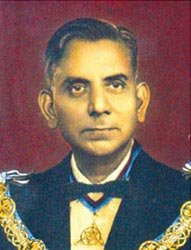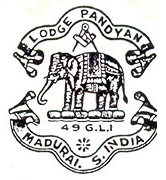REMINISCENCES
August 11, 2025

R.W.Bro. C.A. Ramakrishnan, ICS (Retd.,) OSM, PDyGM, AGM
Initiated in Lodge Pandyan in March 1940
As Lodge Pandyan reaches its hundredth year, the W.M. has suggested that I recall some of my memories of the Lodge. I have been initiated into Free Masonry in Lodge St. Patrick S. C- in 1928 and on taking up a sea – going career, found myself based at Calcutta.
Recalling some of my memories
When I look back on my Masonic career of over 30 years, I am surprised that I became a mason under what may well be regarded as purely accidental and coincidental circumstances.
None in my family had been a mason before me. I had read in the newspapers about the existence of a Freemasons’ Hall in Madras City, where important public functions sometime used to take place. For example, at an Annual Dinner of the Caledonian Society in 1938 or so, held at the Freemasons’ Hall, the then Chief Minister of Madras (Sri C. Rajagopalachari – ‘Rajaji’) had been the Chief Guest, and his speech received very wide publicity. But I could hardly realise then that there was an organisation such as Freemasonry, much less that I could hope to secure admission thereto.
During 1939-40, when I was a junior I.C.S. Officer of about six years’ service, I was working as City First Class Magistrate at Madurai. Towards the end of December 1939, there was a lot of excitement in certain social and official circles in the town at the forthcoming visit of the then Chief Secretary to the Government of Madras, Sir George Boag (He was at the time the District Grand Master of Madras, English Constitutions, a fact which I came to know only much later, of course). It was talked about that apart from his other engagements, the Chief Secretary was going to consecrate the newly constructed Masonic Temple at Madhurai.
As a junior I.C.S. Officer, I was naturally curious to know something about the institution in which the Chief Secretary (the Senior most I.C.S. officer in the state and the Head of the Civil Services)was taking so much interest. One of the local Government Assistant Surgeons (Capt. C.S.S. Sarma) was already a good friend of mine, and he told me that he was himself a Mason, that it was a very good institution, and that if I was interested he would take the necessary steps for my joining the local Lodge Pandyan. I naturally accepted the offer immediately, as I had no hesitation in deciding that an institution in which the Chief Secretary was taking so much interest could not but be a good institution. I was also persuaded by the fact that my friend Capt. Dr. C.S.S. Sarma who was always of a cheerful and helpful disposition, was in the institution, and that I would keep company with him in the Lodge.
Looking back, I have to admit that I happened to join Masonry owing to a combination of adventitious circumstances.
R.W.Bro. C.A. Ramakrishnan
I was initiated in Lodge Pandyan (then in the English Constitution and now No.49 G.L.I) in March 1940, and passed to the Fellow Craft’s degree in April 1940. However, a few days later, I was transferred form Madurai to distant Narasapatnam in Vizagapatnam District, with the result that I could not take my third degree in Lodge Pandyan. There was no Masonic Lodge at Narasapatnam, and I had to wait till I was later transferred to Vizianagaram, where in Lodge Nicopolis (now No,81 G.L.I.) I was raised to the sublime degree of Master Mason. By this time, my good old friend Capt. Dr. C.S.S.Sarma had also been transferred as District Medical Officer, Vizagapatnam, and I was soon to realise what a true Mason he was.
In 1945, when I was still at Vizianagaram, my only child and daughter was about 6 years old. One day she developed sore throat, and the local Sub-Assistant Surgeon was treating her. She was not responding to the treatment even after two or three days. As chance would have it, Capt. Dr. Sarma happened to talk to me on the phone from Vizagapatanam on some official matter, and he casually inquired about the health of the family. When I told him about my daughter’s sore throat, he immediately evinced anxiety and instructed the local Sub-Assistant Surgeon to take a swab from the throat and send it urgently to the Headquarter Hospital at Vizagapatam for bacteriological examination. This was done, and a few hours later, Capt. Dr. Sarma rang me up from Vizagapatam to say that the swab test showed that my daughter was suffering from diphtheria and the she must immediately be brought to the Headquarter Hospital for necessary treatment. I received his message at about 10 p.m., and proceeded immediately to Vizagapatam with my sick child, and reached there at about 1 a.m. Inspite of the inconvenience of the hour, Capt. Dr Sarma met me and arranged for all the facilities for the immediate treatment of my daughter. My wife stayed in his house for a number of days till my daughter fully recovered from the diphtheria illness.
It was only subsequently that I learnt that diphtheria in the case of small children is a deadly and often fatal disease, and that the time factor is most important in the diagnosis and treatment of the disease. There is small doubt that but for the timely and competent help of my friend Capt. Dr. Sarma, my daughter would not be alive today, happily married and the mother of two children.
It is quite possible that what Capt. Dr. Sarma did not me is what any true friend would do in similar circumstances, but in this case the friendship was hallowed by the bonds of Freemasonry, and the friend was none other than the brother who had brought me into the Order. I feel sure that the teacings of Freemasonry had whetted and quickened the naturally helpful and friendly instincts of this fine gentleman.
Years later, I was able in some small measure to repay the debt I owed him. He became involved in some official trouble as District Medical Officer in some other district, and when he mentioned the matter to me, I did all that I could to mitigate his difficulties. This true Mason was called to the Grand Lodge. Above about 6 years ago, leaving behind many to regret his passing way.
During the 1950s and early 1960s, Masonry in South India was dominated by three Masonic giants – R.W.Brethern T.V. Muthukrishna Iyer, Dewan Bahadur D. Sreerama Sastri and Rao Bahadur S.T.Srinivasagopalachari. It was my unique privilege to have known all these three eminent Masons intimately. The first taught me to take Masonic duties and responsibilities seriously; the second taught me to be always loyal to the Order and never think of leaving it, and the third impressed upon me the need to be very careful while selecting persons to constitute one’s team in any Masonic effort. I would deem Masonry worthwhile if it brought me nothing more than the esteem and affection of such persons as these three.
Looking back, I have to admit that I happened to join Masonry owing to a combination of adventitious circumstances. But this was so because of those days, information about Masonry was not so easily made available, and perhaps Masons were under the impression that they should be secretive about the institution. The policy adopted by the Grand Lodge of India – namely, to encourage Lodges to invite non-Masons to the social side of Masonry – has marked a healthy and welcome departure from previous convention. The institution is too good, and there is such a vast reservoir of potentially good candidates outside that every mason should feel it his sacred duty to pass the good word about the Order to all non-Masons in his circle of trusted friends, so that more and more persons in this country may see the Masonic light.

